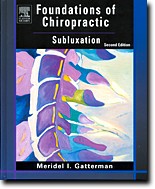








| |
|
|
|
|
| |
|
|
|
|
|
| Dynamic Chiropractic December 2, 2005, Volume 23, Issue 25 |
Printer Friendly Version E-mail to a Friend |
|
|
|||||||||||||
| Title: | Foundations of Chiropractic: Subluxation, 2nd edition |
| Author/editor: | Meridel I. Gatterman, MA, DC, MEd |
| Publisher: | Elsevier Mosby |
| Part #: | T-286 |
 The second edition of Foundations of Chiropractic:
Subluxation, organized and written by Dr. Meridel Gatterman (with 27 other leading authors), is unmistakably
the best book on this topic that I have read so far. They tell it like it is, using all
of the available subluxation research they could find. We have all seen and
reminisced about the miracles of chiropractic, and our patients do love our work. However, a
lot of questions still may be unanswered. This book will help bring you up to speed,
page-by-page, in textbook fashion.
The second edition of Foundations of Chiropractic:
Subluxation, organized and written by Dr. Meridel Gatterman (with 27 other leading authors), is unmistakably
the best book on this topic that I have read so far. They tell it like it is, using all
of the available subluxation research they could find. We have all seen and
reminisced about the miracles of chiropractic, and our patients do love our work. However, a
lot of questions still may be unanswered. This book will help bring you up to speed,
page-by-page, in textbook fashion.
Some of the answers are here. The chapters are deep, filled with facts that require some slow reading and thought. Foundations of Chiropractic: Subluxation is divided into three parts, each with multiple sections organized with a quick review of each chapter, along with keywords and questions for the reader.
Part one, titled "The Subluxation," discusses what we know - how chiropractors find, diagnose and treat the subluxation. Part two, "The Subluxation Complex," is all about biomechanics and neurology (always loads of fun to read about). Part three, "The Subluxation: Syndromes," is a review of our knowledge and approach to commonly seen conditions, signs and symptoms that develop from subluxations. Appendix A outlines the information in part three. Appendix B completes the book with a few pages on what is known about the global effects adjustments have on the nervous, cardiovascular, digestive, and female reproductive systems.
Although this text is upbeat and optimistic, at times I actually found it a bit depressing in the sense that it acknowledges some of our weaknesses in data collection, understanding and double-blind studies. After reading this book, it is clear that as a profession, we do not document and publish our successes in clinical practice to the same degree as other health care providers. Nevertheless, what has been written so far over these past 100-plus years has brought some proof and clarity to our work. To say the least, more must be done.
A fantastic point reinforced in the later chapters of this book will benefit doctors, patients or even insurance carriers who are not clear on the benefits of maintenance care. If a joint is not moving well, is fixed/subluxated, and is not corrected, the restriction will worsen over time, until eventually the normal mobility will be lost and become irreversible. When biomechanics are altered, what effect does it have on the neuromusculoskeletal system? Buy the book and find out!
To order a copy of this book, call (800) 359-2289 or visit www.ChiroMall.com.
If you have authored, published or produced a book or an audio, video or software product that is chiropractic-oriented, educational, nonpromotional and written or produced in a professional manner, and would like it reviewed in Dynamic Chiropractic, please send two copies of the book or product to:
Review Editor
Dynamic Chiropractic
P.O. Box 4109
Huntington Beach, CA 92605
Items submitted for review will not be returned.
Dr. Kintish's Rating:
10+ out of 10
![]()

| Dynamic Chiropractic December 2, 2005, Volume 23, Issue 25 |
Printer Friendly Version E-mail to a Friend |
|
To report inappropriate ads, |